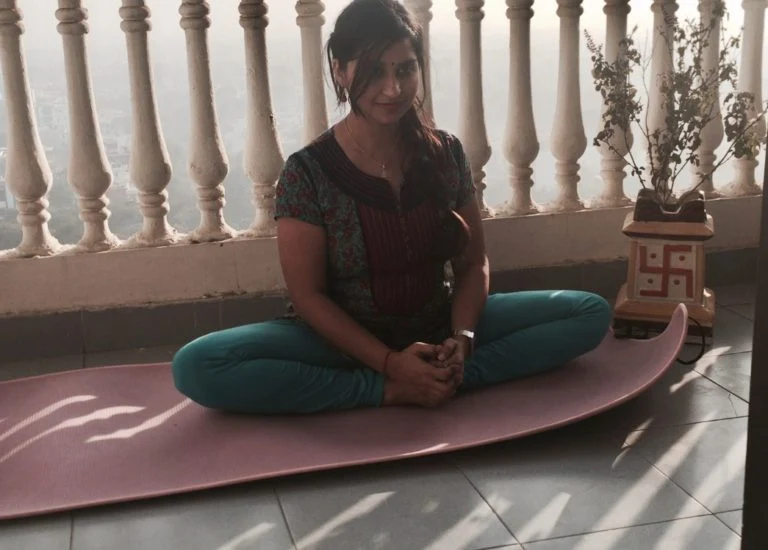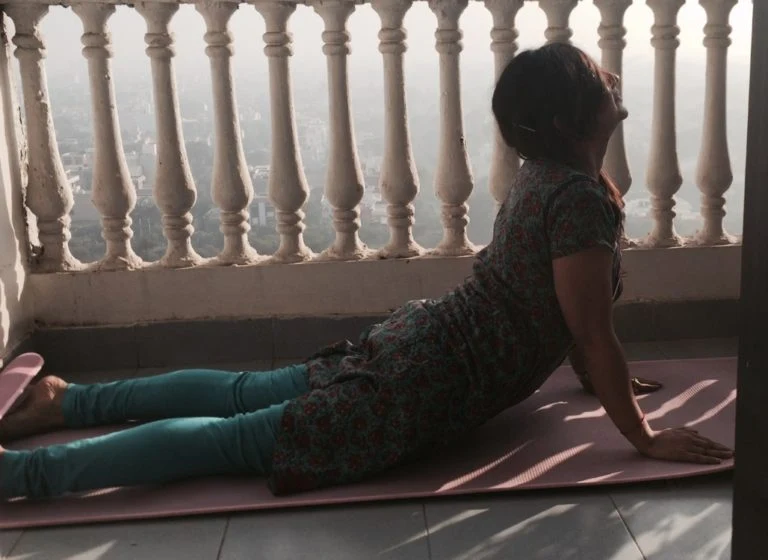 |
| Seated Heart Opener (Vajrasana-variation) |
- Sleep plays an important role in your physical health, in regulating moods and reducing stress. If you habitually do not get a good night’s sleep, chances are that you may be aging faster than you should be, in addition to not feeling well and confused thinking. When we sleep, our body repairs on a cellular level and removes toxins. It is therefore necessary to get at least six to eight hours of sleep daily.
- But no matter how hard you try, you just cannot sleep peacefully. Insomnia is a very common problem nowadays. Due to our hectic lives, irregular food timings, stress and thus many other triggers, most of us have lost our night’s peaceful sleep.
- You have being feeling tired and sleepy the whole day, couldn’t concentrate on anything and constantly thinking about your bed and blanket.
- Now, Its 12:00 midnight—you’ve put the finishing touches on tomorrow’s presentation, put on your night cream, done some much-needed laundry, and read all messages on your phone. You are underneath the blanket, keen to capture a few hours of shut-eye.
- The problem is, you can close your eyes but your brain—refuse to close.
The occasional sleepless night, while annoying, is no big deal. Chronic insomnia however, can pose a serious threat to your health and well being. For example, sleep is involved in healing and repair of your heart and blood vessels. Talking about some serious problems, ongoing sleep deficiency is linked to an increased risk of heart disease, kidney disease, high blood pressure, diabetes, and stroke.
Harvard University researchers recently discovered that a regular yoga practice helped people fall asleep faster, stay asleep longer and improved the overall quality of their rest.
It forces you to be present, slowing down all the worries that collect throughout the day.”
One way you may be able to snatch some extra shut-eye is by adopting a nightly yoga routine. You don’t have to be a die-hard yogi to reap valuable sleep benefits. Lets begin our yatraa…
Just Breathe:
This is a must lesson in my first yoga session, applicable for all age groups. People generally gets stunned that all these years they have been following wrong pattern of breathing.
- Yoga goes beyond just bending and twisting. Breathing techniques play an essential role in grounding the body and opening the mind.“belly breathing,” or abdomen breathing a respiration method people often use to relax and rejuvenate while practicing yoga.
- Put one hand on your belly and inhale, expanding your belly like a balloon. Each time you inhale, try to relax and inflate your belly as much as you can.
- Yoga also encourages you to tune in to the present moment, often by focusing on the breath, which allows you to stop worrying about things that happened in the past or might happen in the future.
- While there isn’t one specific pose that will automatically send you into a deep sleep,
- Here are simple sleep-stimulating yoga poses to try, so lets begin our yatraa…
- Reclined Butterfly: Deepen the benefits of the simple butterfly pose with Supta Baddha Konasana (Reclining Butterfly Pose). Ease the fatigue experienced from extended walking and standing with this particular pose. It also helps in stretching your legs, groins, inner thighs, and even hips. Close your vision and concentrate on your breathing pattern, and find out how your body relaxes its method to a good night’s sleep.
 |
| Reclined Butterfly Supta Baddha Konasana (Reclining Butterfly Pose). |
This pranayama can help you relax completely and allows the body to cool down. You can do it either to take a seat in Sukhasana (Easy Pose) or Padmasana (Lotus Pose) or even by lying down to your right. Close your right nostril completely and left nostril partially. Inhale using your left nostril, close it entirely, and then exhale through your correct one. In this breathing exercise, you usually breathe in with the left nostril and breathe out through your right. One inhalation and something exhalation make one round. That you can do 5 to 10 such rounds to place yourself at peace.
Butterfly Pose (BaddhaKonasana): This pose can help remove fatigue from long hours of standing or walking. Also a good stretch for inner thighs, groin and knees. Relaxes your thigh muscles and pelvic region, stimulates the heart relieving mild depression and pain in the legs.
 |
| Butterfly Pose (BaddhaKonasana) |
Imitating a young child at rest – nothing is more peaceful than this pose. Relax the back, calm your nervous system, and recline the right path to sleep.
Yoga poses that can be done while lying in bed include Happy Baby (Ananda balasana), which releases the low back and hips, leaving you feeling looser and more relaxed. It is perceived that a happy baby rolls around while they are holding their feet in the air. Well, this pose mimics half of that.
If you choose, you can also do this pose in full. Either way, you will find yourself sleeping peacefully after the relaxing effects of the half happy baby. A deeply relaxing stretch for the back which also helps calm the nervous system so that you can sleep at peace.
Plow Pose (Halasna):
The plow pose, or Halasana in Sanskrit, is another spine stretching yoga pose that works wonders for sleeping issues. It helps unwind stress at the end of the day and get better sleep at night.
This yoga stretch can help you to relax and enjoy a peaceful sleep. This pose helps stretch out your back and neck muscles, reducing physical tension and relaxing your body.
 |
| Plow Pose (Halasna) |
Cobra Pose (Sarpasana): It is great for opening the chest and strengthens your core body. It helps to align the spine and helps invigorate the kidneys and nervous system. Do not do this pose if you have had recent injury to your back, arms, and shoulders, are pregnant, or had recent abdominal surgery.
 |
| Cobra Pose (Sarpasana) |
Seated Heart Opener (Vajrasana-variation): Now this one is an amazing pose. Sit in a kneeling position, if you can. If you suffer from knee issues, then you can sit with your legs extended out in front of you. Put your hands on the ground behind you, palms on the floor and fingers facing away from your body. Inhale and lengthen your spine. Exhale and lean backwards, arching your back and lowering your head behind you.
 |
| Seated Heart Opener (Vajrasana-variation) |
Corpse Pose (shavasana)
Yoga nidra is a deep relaxation methodology that can be particularly helpful for people who have trouble sleeping. Corpse Pose (shavasana) ends every yoga class, and it’s a good way to end your day too. Lying in bed, focus on each part of your body and soften it before moving on. Begin with the toes, move up the legs and arms, through the torso to the neck, face and head.
Then spend a few minutes just breathing. If you find your mind wandering during this time, don’t engage in your thoughts; instead, bring your attention back to your breath. This helps create a break from your active mind and allows you to relax for sleep.
Yog Nidra after meals helps relax the entire system.
Cat Stretch (Marjariasana):
Excellent stretch for spine flexibility. Do you see a pattern here? A lot of these poses involve stretching the neck and spine. Maybe this is why it feels so good when we stretch in the morning?
So, to do this, you are going to want to get on all fours and spread your fingers wide making sure your hands are under your shoulders and knees under your hips. Inhale and tuck your tailbone, round your back, and look at your belly.
Exhale, drop, arch your lower back, and look up. This is what it takes to do the very simple Cat/Cow pose to help you fall asleep easier.
Also helps massage the digestive organs and improve digestion, thereby helping you to sleep well. Also improves blood circulation and relaxes the mind.
Other Tips to Help You Sleep Better :
- Keep a gap of at least two hours between your last meal and sleep.
- If you have had a quarrel with your partner or loved one, make sure you sort it out before you go to sleep. Carrying it on may not just give you a disturbed sleep but may also spoil the following day.
- Avoid watching a horror movie late night as the thought of it will keep lingering in your mind all through the night. It’s a good idea to listen to soft instrumental music, such as that of veena,chant or listen to chants or knowledge before getting ready to sleep.
- Make your own sleep pattern. Sleeping any time during the day is not advisable. It disrupts the biological clock. Sleep experts often point to the efficacy of creating a standard nighttime routine in order to signal your body that it’s time to prepare for sleep.
Posted by: Yoga Teacher: Prachi Shandilya














I will
ReplyDelete